Oude Kerk, Tony Oursler, 2014
A version of this article originally appeared on The Creators Project Netherlands. “You have no consciousness down below,” a huge, projected face says as I pass beneath a stained-glass window in the Oude Kerk (Old Church) in Amsterdam. “The machine will work until you die.” It's part of I/O Underflow, video artist Tony Oursler’s first solo show in the Netherlands in 20 years, an exhibition created using the massive gothic church as a canvas. For it, Oursler projects a series of videos of talking heads that comment on our internet culture in disturbing, funny, and often cryptic ways.He also unveiled X Ergo Y this past weekend, a 20-minute, looping, large-scale art video projected onto the colossal white façade of the Stedelijk Museum in Amsterdam. Shot especially for the Stedelijk Museum in Oursler's New York studio, the luminous installation is the first artwork ever to be projected on the outside of the newly-renovated museum, running every morning and evening through January 16.In the past, Oursler has manipulated creepy puppets for a David Bowie music video, and projected faces onto bulbous sculptures. I spoke to him about the ideas behind the exhibitions, the links between the two works, and his connection to the city of Amsterdam.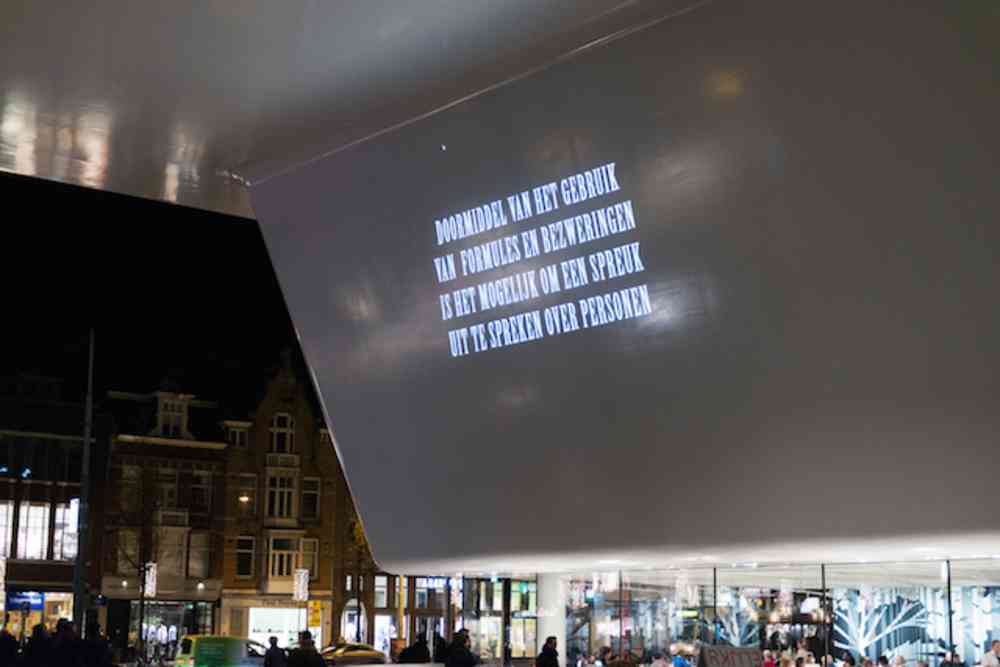 The Creators Project: Let’s start off with your exhibition in the Oude Kerk. What's it about?
The Creators Project: Let’s start off with your exhibition in the Oude Kerk. What's it about?
Tony Oursler: The exhibition is about the relationship between man and machine, and how early notions of what the computer might become relate to the conflict of the modern digital era, in which humanity is slowly lost in a stream of digital information.What does the title, I/O Underflow, refer to? Is there some sort of warning present?
I was looking for a title that could bring that idea across. 'I/O' refers to input/output, but it also hints to one/zero and on/off, as a kind of analogy for the binary language of the machine. 'Underflow' comes from an expression in engineering that describes how, when you have mass data, small deviations or anomalies can get "lost in the underflow." Those deviations might be insignificant for the machine itself, but to you and me can be very important events, like maybe even our lives. To me a title is not so much a description of what is to come, but a way to get people to ask questions right off the bat. In a way it’s the start of the exhibition itself—if it’s a good one, at least.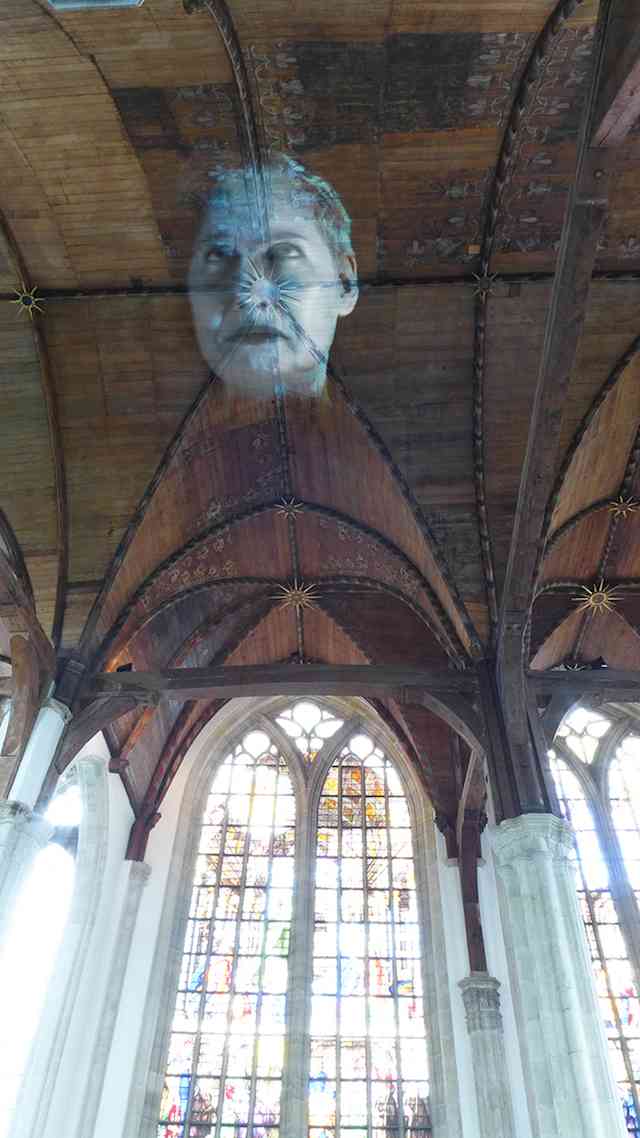 In the church, we’re confronted with various larger-than-life faces that all seem to warn us about the issues surrounding of our digital lives and the glorification of technology. Why did your work take this particular form?
In the church, we’re confronted with various larger-than-life faces that all seem to warn us about the issues surrounding of our digital lives and the glorification of technology. Why did your work take this particular form?
The exhibition is this kind of scattered, cacophonic analysis of where we, as humanity, are today. I use the story of the life of Alan Turing, who I take as ‘the inventor of the machine,’ to see how the ideas of what the computer could be have influenced what it is today. The talking heads are a sort of stand-in for humanity in that way. It has always been a recurring theme in my work, kind of an endless fascination. They’re people, but some are already crossing over to the other side and turning into these weird, obsessed robots. It’s up to the visitor to determine with whom they identify, and thus where they stand in that dialogue.Why is the Oude Kerk the best place to tell that story?
I think one of the subtexts of the digital age is about this battle between mysticism versus rationalism. The computer has always taken the position of the ratio, the church that of mysticism. In this exhibition I’ve tried to "hack" the church and have them switch places, so that the machine becomes something mystical and the church becomes the matter itself, the ratio. In the history of cinema they brought this idea up that the spectacle of the church was replaced by the spectacle of the screen. And I think you can argue that continues with the digital world, with its own mythology and characters: you have the hackers, the trolls, the businessmen and the money fortresses. In a way, the internet is the grim fairytale of our time. I think it’s fitting to tell that story in a church.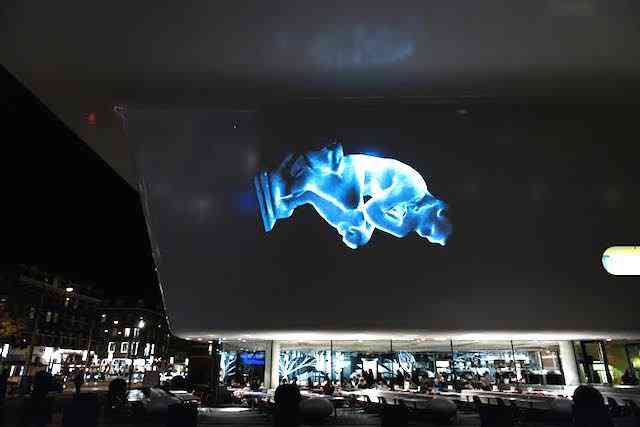 Over to the Stedelijk: can you tell me a bit more about what will be projected on the museum?
Over to the Stedelijk: can you tell me a bit more about what will be projected on the museum?
X Ergo Y is about our human belief systems: which visions and worldviews have we constructed over time to get a grip on reality? In the installation, I interchange moving 3D-objects with various text statements that are projected on the building. The images are a kind of mysterious, totemic representations who all reveal a certain view on the world, or visualize a belief in something. So you will see Rodin’s The Thinker, but also a voodoo doll or indigenous spiritual masks. Interspersed there are these statements that I present to the public, that always result in you either agreeing or disagreeing with them. “I believe in god,” “Mind reading is not possible,” or “The Loch Ness Monster of Scotland exists.”What's the purpose of those statements?
I hope that every time you see the work you question yourself if you agree with that statement or not. People don’t seem to talk about it anymore, but I think it’s very interesting to ask people: well, what do you believe in? Even if it’s just for a second. Or, if you want, you can also decide to hang around for the full 20 minutes of the work.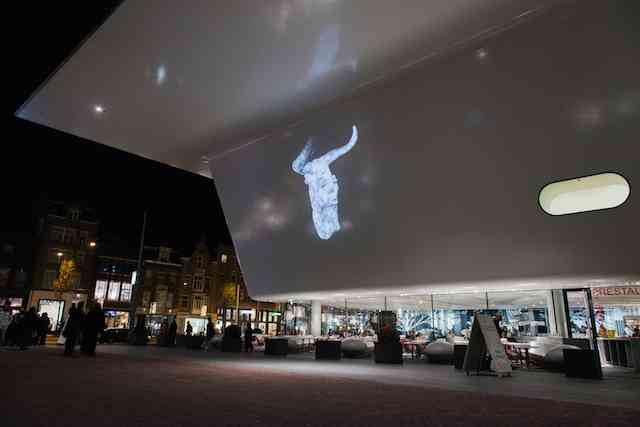 Lastly, does it feel good to be back in Amsterdam after 15 years?
Lastly, does it feel good to be back in Amsterdam after 15 years?
Absolutely. This is the city where I had my first European installation, also in the Stedelijk Museum. So that was really important to me. I loved coming here, hanging around, doing drugs and making art. This place really was a beacon of liberalism, especially in the 80s. I think the world has caught up by now—marijuana is legal in New York, practically—but this city has meant a lot to the artists of my generation. So it’s very exciting to come back here and see the Stedelijk is opened again and that places such as the Oude Kerk are getting opened up for cultural things as well. It seems like a great moment. Like the city is slowly regaining its momentum. Artists always like that fresh energy, I think. I’ve always considered Amsterdam to be at the forefront of something. Now’s the time to determine what it will be in.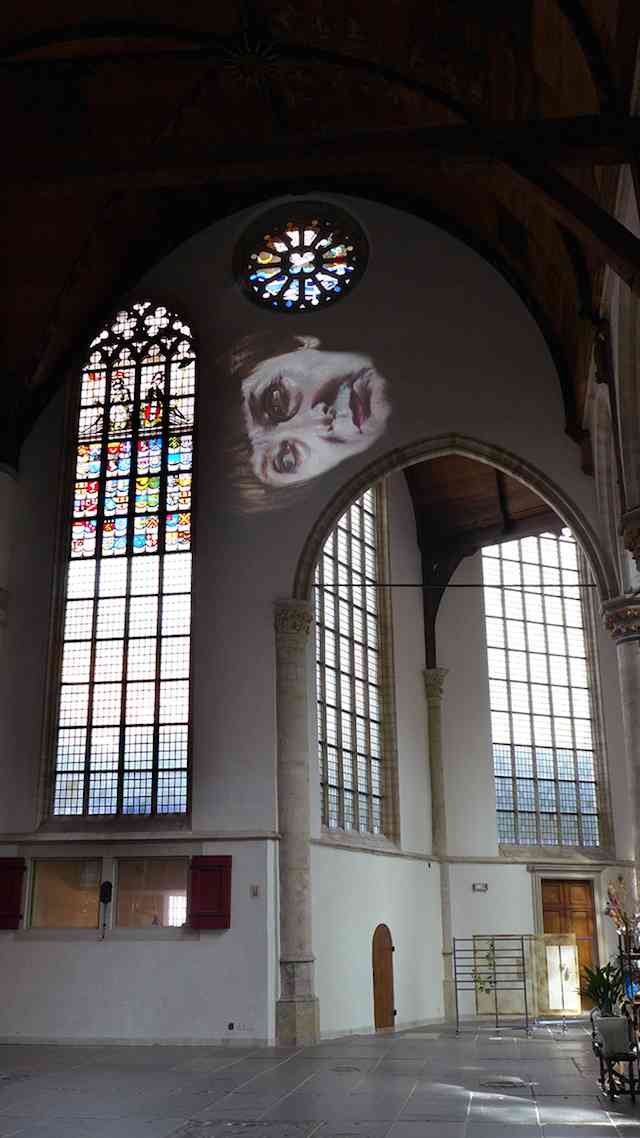 The I/O Underflow exhibition will be on display through March 29, 2015 in the Oude Kerk. Click here for more info. The X Ergo Y video installation will be visible on the Stedelijk Museum until 16 Januari 2015, every morning (7:00-9:00 am) and evening (5:00-11:00 pm). Click here for more info. Visit Tony Oursler's website for more work from the artist.Related:Remember Nam June Paik, The "Father Of Video Art," At New ExhibitionI Looked Into The Void And Saw Marina AbramovicI Explored 'MultiVerses' With Artist Shea Hembrey
The I/O Underflow exhibition will be on display through March 29, 2015 in the Oude Kerk. Click here for more info. The X Ergo Y video installation will be visible on the Stedelijk Museum until 16 Januari 2015, every morning (7:00-9:00 am) and evening (5:00-11:00 pm). Click here for more info. Visit Tony Oursler's website for more work from the artist.Related:Remember Nam June Paik, The "Father Of Video Art," At New ExhibitionI Looked Into The Void And Saw Marina AbramovicI Explored 'MultiVerses' With Artist Shea Hembrey
Advertisement

Tony Oursler: The exhibition is about the relationship between man and machine, and how early notions of what the computer might become relate to the conflict of the modern digital era, in which humanity is slowly lost in a stream of digital information.What does the title, I/O Underflow, refer to? Is there some sort of warning present?
I was looking for a title that could bring that idea across. 'I/O' refers to input/output, but it also hints to one/zero and on/off, as a kind of analogy for the binary language of the machine. 'Underflow' comes from an expression in engineering that describes how, when you have mass data, small deviations or anomalies can get "lost in the underflow." Those deviations might be insignificant for the machine itself, but to you and me can be very important events, like maybe even our lives. To me a title is not so much a description of what is to come, but a way to get people to ask questions right off the bat. In a way it’s the start of the exhibition itself—if it’s a good one, at least.
Advertisement

The exhibition is this kind of scattered, cacophonic analysis of where we, as humanity, are today. I use the story of the life of Alan Turing, who I take as ‘the inventor of the machine,’ to see how the ideas of what the computer could be have influenced what it is today. The talking heads are a sort of stand-in for humanity in that way. It has always been a recurring theme in my work, kind of an endless fascination. They’re people, but some are already crossing over to the other side and turning into these weird, obsessed robots. It’s up to the visitor to determine with whom they identify, and thus where they stand in that dialogue.Why is the Oude Kerk the best place to tell that story?
I think one of the subtexts of the digital age is about this battle between mysticism versus rationalism. The computer has always taken the position of the ratio, the church that of mysticism. In this exhibition I’ve tried to "hack" the church and have them switch places, so that the machine becomes something mystical and the church becomes the matter itself, the ratio. In the history of cinema they brought this idea up that the spectacle of the church was replaced by the spectacle of the screen. And I think you can argue that continues with the digital world, with its own mythology and characters: you have the hackers, the trolls, the businessmen and the money fortresses. In a way, the internet is the grim fairytale of our time. I think it’s fitting to tell that story in a church.
Advertisement

X Ergo Y is about our human belief systems: which visions and worldviews have we constructed over time to get a grip on reality? In the installation, I interchange moving 3D-objects with various text statements that are projected on the building. The images are a kind of mysterious, totemic representations who all reveal a certain view on the world, or visualize a belief in something. So you will see Rodin’s The Thinker, but also a voodoo doll or indigenous spiritual masks. Interspersed there are these statements that I present to the public, that always result in you either agreeing or disagreeing with them. “I believe in god,” “Mind reading is not possible,” or “The Loch Ness Monster of Scotland exists.”What's the purpose of those statements?
I hope that every time you see the work you question yourself if you agree with that statement or not. People don’t seem to talk about it anymore, but I think it’s very interesting to ask people: well, what do you believe in? Even if it’s just for a second. Or, if you want, you can also decide to hang around for the full 20 minutes of the work.

Absolutely. This is the city where I had my first European installation, also in the Stedelijk Museum. So that was really important to me. I loved coming here, hanging around, doing drugs and making art. This place really was a beacon of liberalism, especially in the 80s. I think the world has caught up by now—marijuana is legal in New York, practically—but this city has meant a lot to the artists of my generation. So it’s very exciting to come back here and see the Stedelijk is opened again and that places such as the Oude Kerk are getting opened up for cultural things as well. It seems like a great moment. Like the city is slowly regaining its momentum. Artists always like that fresh energy, I think. I’ve always considered Amsterdam to be at the forefront of something. Now’s the time to determine what it will be in.
Advertisement
